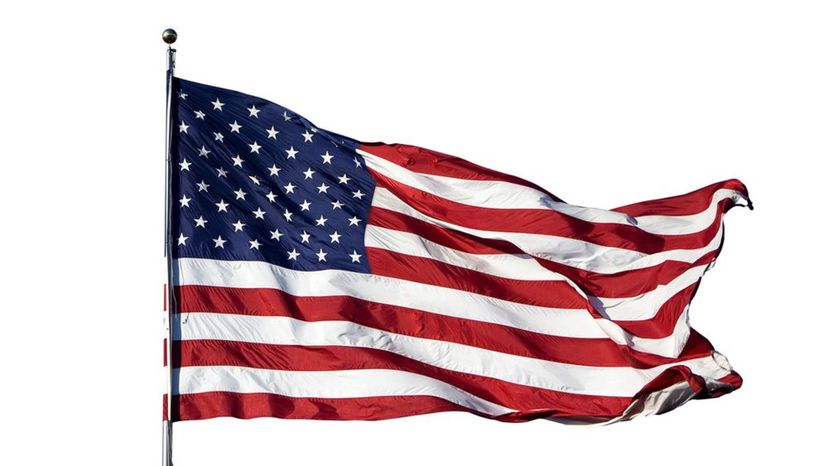
About This Quiz
The American flag is one of the most recognizable national symbols on Earth. The Red, White and Blue has a long and storied background. How much do you know about the history of the United States flag?The current U.S. flag has 13 horizontal stripes. The red stripes and white stripes are different lengths, but they're are all of equal width.
The 13 horizontal stripes, which alternate red and white, represent the 13 British colonies that decided to declare their independence from England. For the British, they were 13 stripes of doom.
The founders of the U.S. adopted the first American flag in 1777, in the middle of the American Revolution. That first flag had 13 stripes and 13 stars.
Advertisement
During the War of 1812, British ships bombarded Fort McHenry in Baltimore Harbor, and lawyer Francis Scott Key witnessed the spectacle. He wrote a poem that eventually became known as "The Star-Spangled Banner."
The original Star-Spangled Banner was purposely big -- 42 feet wide and 30 feet tall. Why? Intimidation. It was so big that the British could see it from a long, long way off.
After the War of 1812, many people cut pieces from the famous flag as souvenirs. Its 42-foot length is now around 30 feet.
Advertisement
The iconic flag required a restoration process. Many cleaning experts and scientists spent nearly a decade working on the flag, at a cost of more than $20 million.
A long-standing legend has it that a Pennsylvania woman named Betsy Ross designed and made the first American flag. But historians have decided that the Ross legend is simply that -- a story that was made up decades after the Revolution.
Fifteen stripes seemed OK … but once the U.S. kept adding states, it was clear that there were going to be too many stripes. So flag designers reverted to 13 and it's been that way ever since.
Advertisement
The stars represent U.S. states. The modern flag features 50 of them.
Hawaii is the most recent U.S. territory to achieve statehood. It was introduced into the Union (with what we're sure was a smashing luau) in 1959.
In 1958, as part of a high school project, a student named Robert G. Heft designed the current flag. He got a B- grade on the project, but it was eventually adopted by the United States Congress.
Advertisement
The flag is often called Old Glory, The Stars and Stripes or just simply Red, White and Blue.
In the late 1960s a lot of Vietnam War protesters took to burning and mutilating American flags, so the government passed the Flag Protection Act, a bit of law that would later create a lot of controversy.
A sea captain named William Driver counted "Old Glory" as his most prized possession. When Rebel soldiers demanded the flag, he wasn't intimidated. He simply said, "Over my dead body," and then hid it, and the Confederates never seized the banner.
Advertisement
The color red doesn't signify blood in any way. It's meant to represent hardiness and valor. White symbolizes purity and innocence. And the blue stands for vigilance, perseverance and justice.
NASA has planted one U.S. flag for each moon landing -- so six in all. Of those six, five of those are still standing tall on the windless lunar surface.
Apollo 11 was the spacecraft that carried the first men to the moon. Exhaust from the moon lander is probably the reason that the first American flag fell over.
Advertisement
In 1953, British climber Edmund Hilary and Nepalese Sherpa mountaineer Tenzing Norgay were the first men to summit Mount Everest. Ten years later, the first American, Barry Bishop, planted the first U.S. flag atop the world's tallest summit.
In 1916, President Woodrow Wilson officially established Flag Day. Celebrated each June 14, it commemorates the adoption of the first national flag in 1777.
It's legal for flag makers to dress up American flags with golden fringe, so long as the fringe doesn't drastically alter the flag's overall look. These flags are most often seen in ritzy settings like official government buildings.
Advertisement
Believe it or not, the arrangement of the stars was never standardized until the adoption of the 48-star flag. Until then, the stars could essentially be placed willy-nilly all over the blue box.
No patriotic citizen wants to see a dirty flag flapping in the breeze. Tradition holds that it's acceptable to lower a flag and then launder it to bring back the glory of the Red, White and Blue.
The so-called Great Star flag was unique in American flag history. It arranged the 26 stars in a distinctive star pattern that's rarely been used in the flag's design.
Advertisement
The second-longest used design was adopted in 1912, and it featured 48 stars. It survived for 47 years, until Alaska became a state in 1959. Its stars were typically aligned in nice, neat rows and columns.
A lot of people get mad when they see American flags being ruined, one reason the Flag Desecration Amendment (or Flag-burning Amendment) was introduced in 2006. The measure was defeated by a single vote in the Senate.
There are no laws against burning U.S. flags. So if you're mad at your local representative, you're totally free to desecrate a flag in his or her honor.
Advertisement
When a flag is displayed for showy purposes, Americans are supposed to stop and put their right hands over their hearts.
Since 1777, the country has transformed itself many times, and with the acquisition of new territory, the flag had to change, too. There have been 27 different American flags.
Don't get too cocky, Americans, Old Glory isn't even close to being the oldest flag. The flag of Denmark, first flown in the early 1300s, is the oldest national flag on Earth.
Advertisement